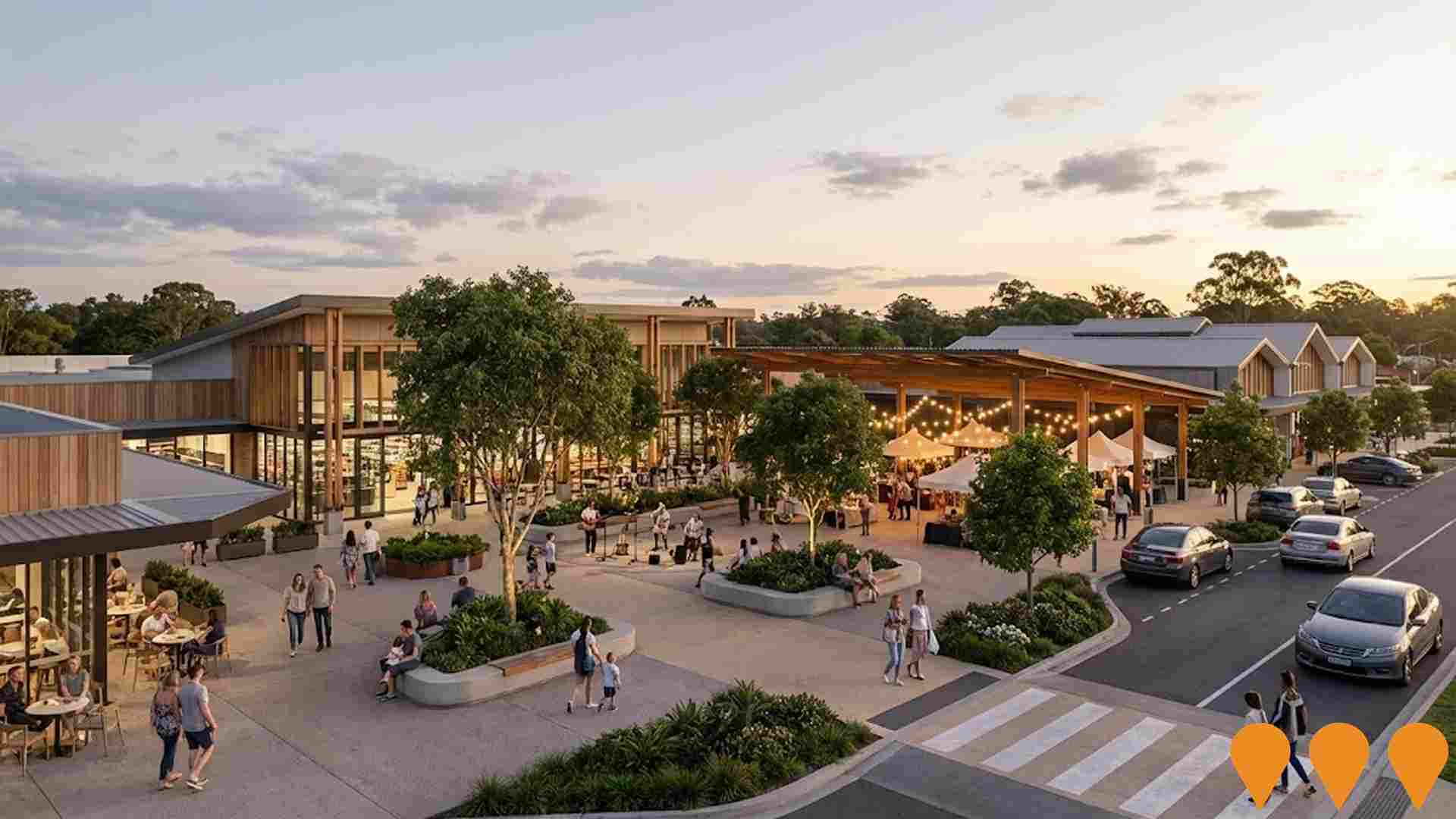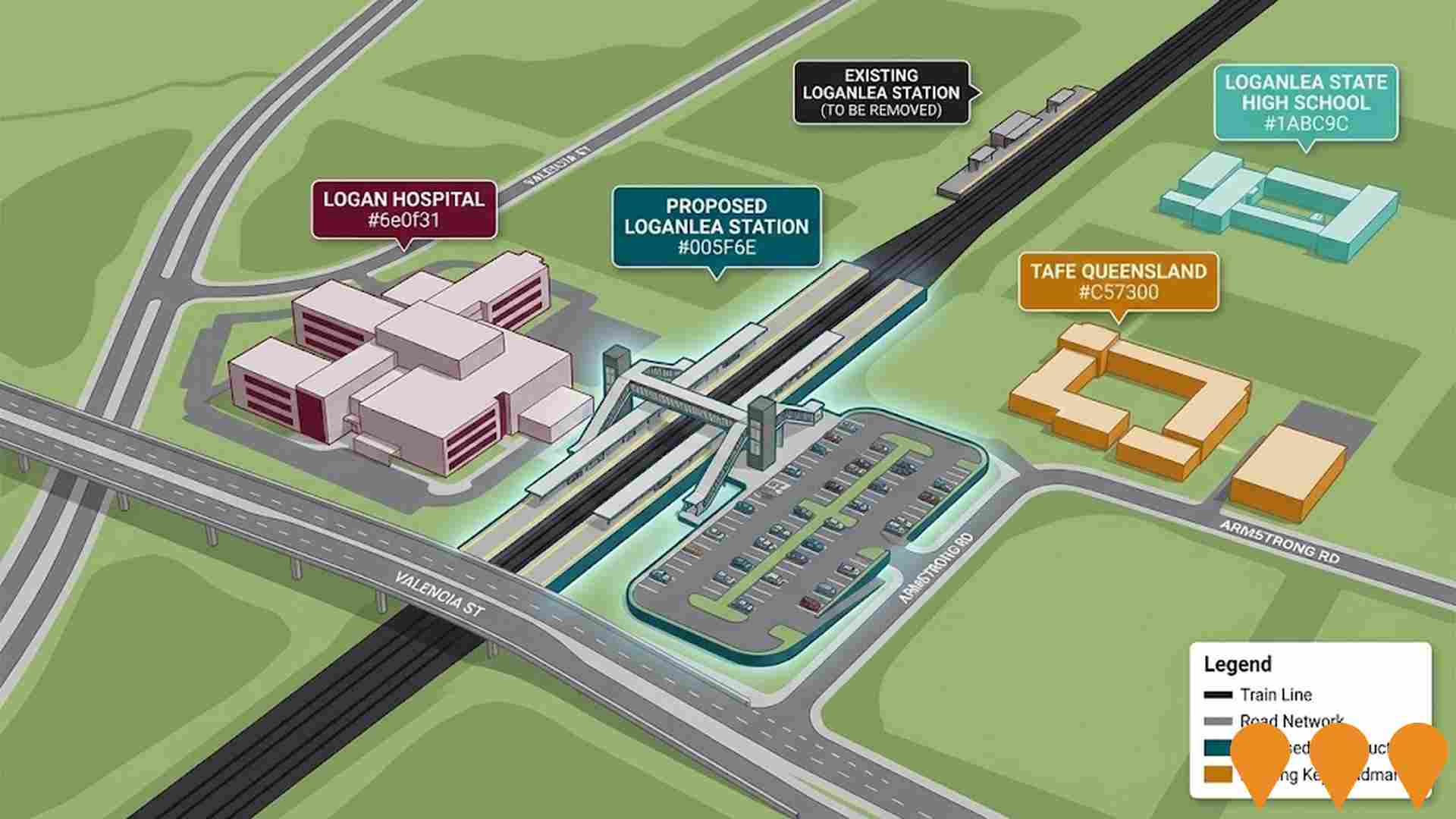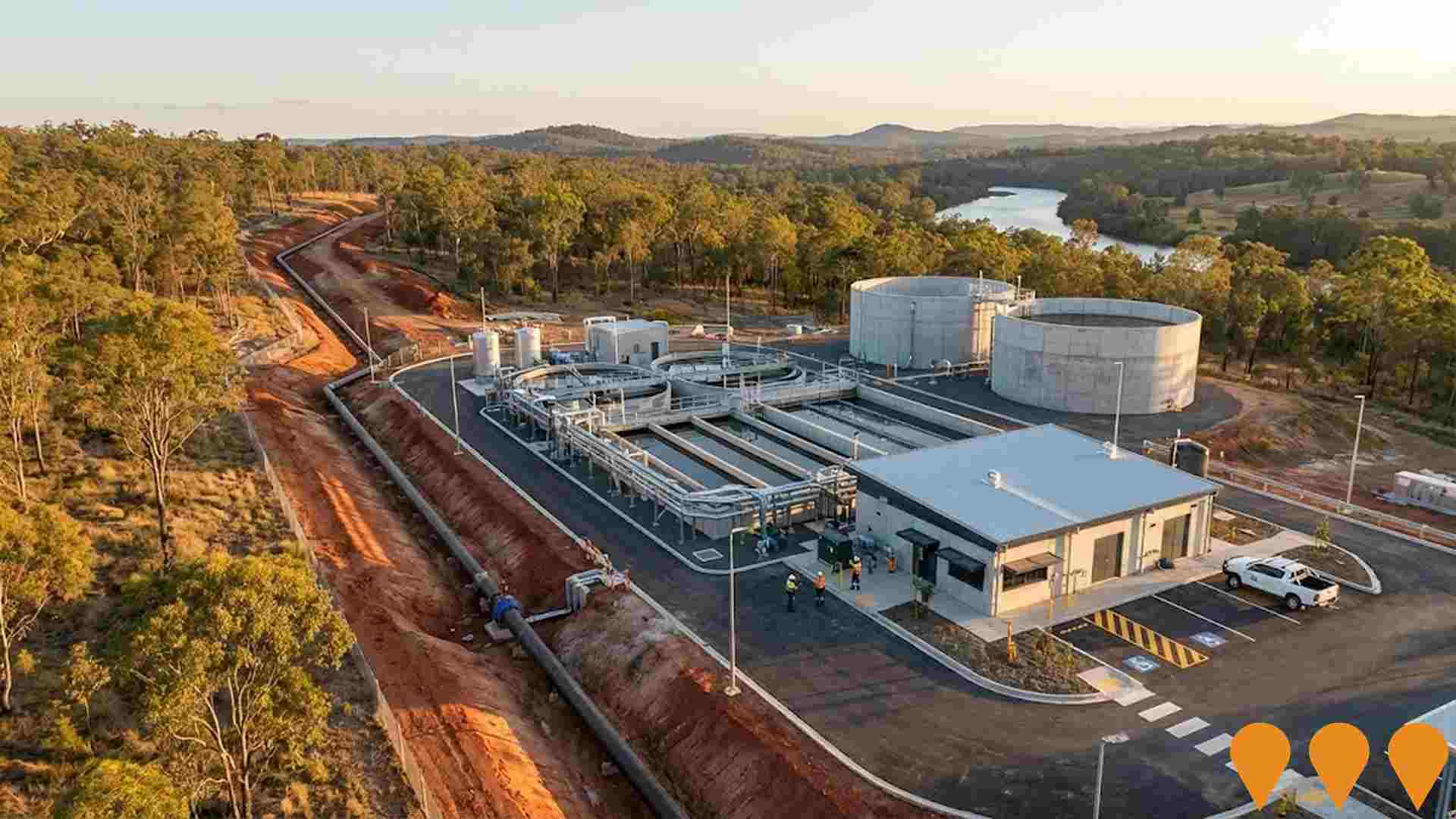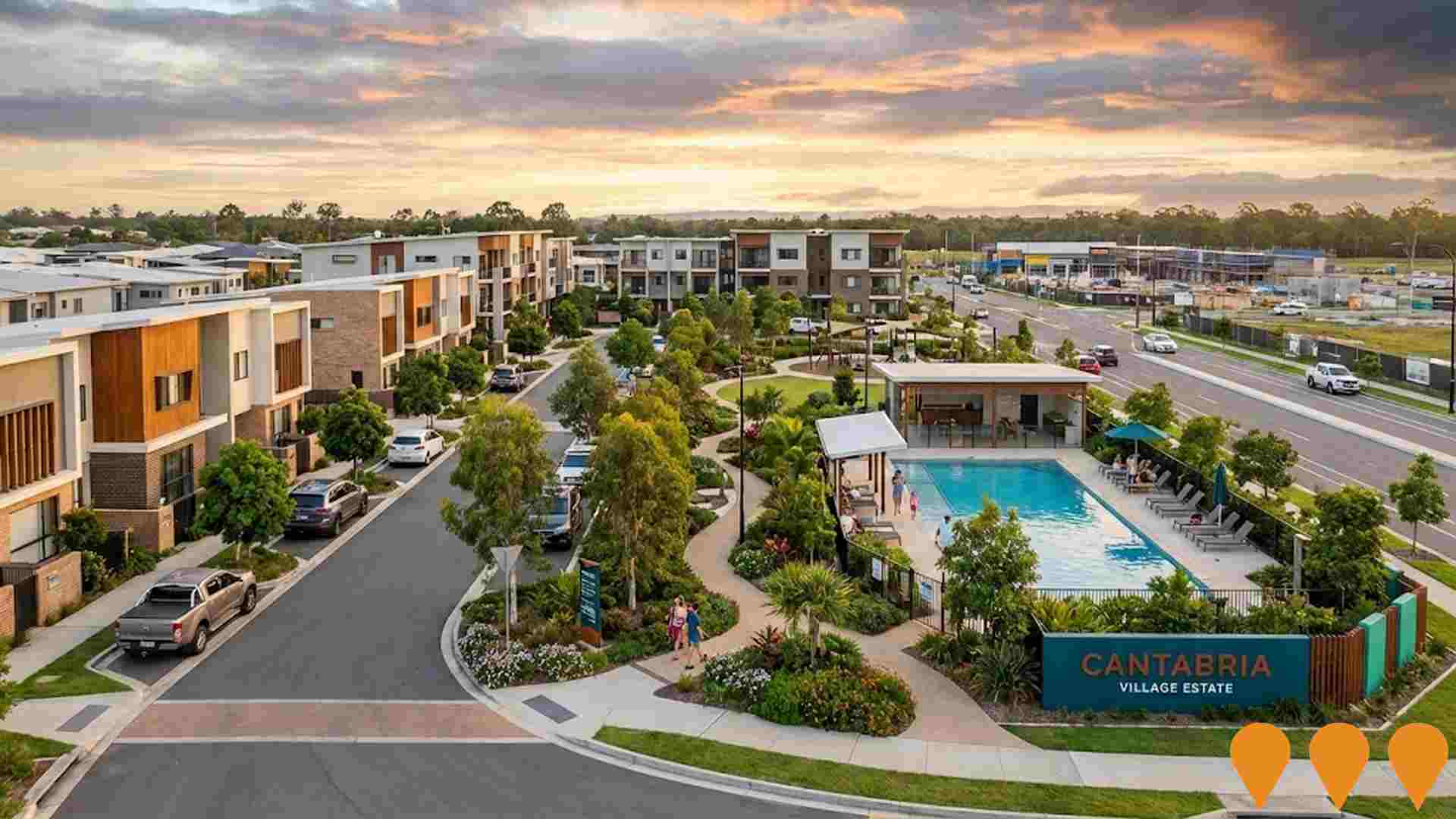Chart Color Schemes
est. as @ -- *
ABS ERP | -- people | --
2021 Census | -- people
Sales Activity
Curious about local property values? Filter the chart to assess the volume and appreciation (including resales) trends and regional comparisons, or scroll to the map below view this information at an individual property level.
Find a Recent Sale
Sales Detail
Population
Bethania - Waterford lies within the top quartile of areas nationally for population growth performance according to AreaSearch analysis of recent, and medium to long-term trends
Bethania-Waterford's population is approximately 13,153 as of August 2025. This figure represents an increase of 1,028 people since the 2021 Census, which reported a population of 12,125. The growth was inferred from ABS estimates of 13,056 in June 2024 and validated new addresses since then. This results in a density ratio of 1,041 persons per square kilometer. Bethania-Waterford's growth rate of 8.5% exceeded the SA3 area's 7.7%, indicating it as a growth leader. Interstate migration contributed approximately 67.5% of overall population gains recently.
AreaSearch uses ABS/Geoscience Australia projections for each SA2 area, released in 2024 with a base year of 2022. For areas not covered by this data and years post-2032, Queensland State Government's SA2 area projections from 2023, based on 2021 data, are adopted. These state projections do not provide age category splits, so AreaSearch applies proportional growth weightings in line with ABS Greater Capital Region projections released in 2023, using 2022 data for each age cohort. Future trends project an above median population growth, with the area expected to increase by 2,078 persons to 2041 based on latest numbers, indicating a total increase of 15.0% over 17 years.
Frequently Asked Questions - Population
Development
Residential development activity is slightly higher than average within Bethania - Waterford when compared nationally
Bethania-Waterford has seen approximately 62 new homes approved annually. Over the past five financial years, from FY-21 to FY-25, around 313 homes were approved, with an additional 4 approved so far in FY-26. On average, about 3.1 people have moved to the area each year for every dwelling built during this period.
This has led to significant demand exceeding new supply, typically resulting in price growth and increased buyer competition. The average construction cost value of new dwellings is around $390,000, which is below regional levels, suggesting more affordable housing options for buyers. In FY-26, commercial development approvals totaled $28.6 million, indicating strong local business investment.
Compared to Greater Brisbane, Bethania-Waterford has slightly higher development activity, at 21.0% above the regional average per person over the past five years. This maintains good buyer choice while supporting existing property values. However, development activity has somewhat decreased in recent periods. The majority of new developments consist of detached houses (88.0%), with medium and high-density housing making up the remaining 12.0%, preserving the area's traditional suburban character focused on family homes. Bethania-Waterford has around 916 people per approval, indicating a mature, established area. Looking ahead, it is projected to grow by approximately 1,976 residents by 2041. Construction is currently keeping pace with this projected growth, although increasing population may lead to growing competition among buyers.
Frequently Asked Questions - Development
Infrastructure
Bethania - Waterford has moderate levels of nearby infrastructure activity, ranking in the top 50% nationally
Changes to local infrastructure significantly affect an area's performance. AreaSearch has identified 21 projects that could impact this region. Notable ones are Bethania to Logan Village Rail Trail, Rosebank Estate, Holmview Central Shopping Centre Stage 2 Expansion, and Beenleigh Train Station Upgrade, with the following list providing more details on those most relevant.
Professional plan users can use the search below to filter and access additional projects.
INFRASTRUCTURE SEARCH
 Denotes AI-based impression for illustrative purposes only, not to be taken as definitive under any circumstances. Please follow links and conduct other investigations from the project's source for actual imagery. Developers and project owners wishing us to use original imagery please Contact Us and we will do so.
Denotes AI-based impression for illustrative purposes only, not to be taken as definitive under any circumstances. Please follow links and conduct other investigations from the project's source for actual imagery. Developers and project owners wishing us to use original imagery please Contact Us and we will do so.
Frequently Asked Questions - Infrastructure
Logan Hospital Expansion
Over $1.3 billion expansion of Logan Hospital delivered in stages. Stage 1 ($460M, largely complete as of 2025) delivered 206 new beds and treatment spaces, new inpatient units, medical imaging, transit care hub, and maternity upgrades. Stage 2 ($874.7M, under construction since late 2024) will add 112 beds, new operating theatres, endoscopy rooms, chemotherapy/day therapy spaces, catheterisation labs, central sterilisation services, expanded pharmacy, and loading dock. Overall project delivers 318 new beds, enhanced clinical services, and 1,506 new parking spaces. Managing Contractor: John Holland. Full completion late 2027.

Yarrabilba Town Centre
Mixed-use town centre for the Yarrabilba masterplanned community, delivering approximately 30,000 mý of retail and commercial floorspace, civic facilities, higher-density residential apartments and improved east-west road connections. Forms the central hub of the 2,222-hectare Yarrabilba Priority Development Area.

Yarrabilba Priority Development Area
Large master-planned community in Logan, Queensland, designated a Priority Development Area (PDA). The overall development is expected to span 20-30 years, providing up to 20,000 dwellings for a population of up to 50,000 residents. Recent activity includes construction on the Yarrabilba Business Park (forecast opening early 2026), the Jimbillunga Drive/Wentland Avenue extension, and a new intersection on Waterford-Tamborine Road (completion mid-2027). Planning is underway for a major Town Centre (Precinct 7) with retail, dining, and commercial uses, including potential high-density development up to 8 storeys.

The Avenues Loganholme
Proposed high-density mixed-use residential precinct opposite Hyperdome featuring up to 1,200 apartments, retail podium, and public realm upgrades.

Waterford West Community Hub & Town Centre Redevelopment
Logan City Council-led place-making project to transform the local centre at 909 Kingston Road into a vibrant community hub with improved retail, public spaces, playground, and better connectivity as part of a broader Place Plan.

Loganlea Station Relocation
The relocation and upgrade of Loganlea railway station to a new site 500m south, directly opposite Logan Hospital. The $173.76 million project will deliver improved accessibility, safety, and connectivity to Logan Hospital, Loganlea TAFE, and Loganlea State High School. Features include dual lifts on each platform, pedestrian overpass, 400-space park and ride facility, new station building with real-time displays, raised accessible platforms, and enhanced lighting and CCTV for safety.

Logan Water Infrastructure Projects
Essential water infrastructure upgrades including new pipelines, treatment facilities and storage systems. Designed to support population growth and improve water security across Logan region.

Beenleigh Train Station Upgrade
Major station relocation 650m north as part of Logan and Gold Coast Faster Rail project. New accessible station with lifts, straightened platforms, multi-storey car park, improved integration with town square. Includes closure of Holmview Road and Spanns Road level crossings.

Employment
Employment conditions in Bethania - Waterford remain below the national average according to AreaSearch analysis
Bethania-Waterford has a balanced workforce with both white and blue-collar jobs. The construction sector is prominent, with an unemployment rate of 4.0%.
In the past year, employment grew by 5.3%. As of June 2025, 6,349 residents are employed, with an unemployment rate of 3.9%, compared to Greater Brisbane's 4.1%. Workforce participation is lower at 52.3% versus Greater Brisbane's 64.5%. Key industries include health care & social assistance, construction, and retail trade.
Construction employment is particularly high, at 1.5 times the regional average. Professional & technical services have limited presence, with only 3.3% of jobs compared to 8.9% regionally. Most residents work outside the area. Between June 2024 and June 2025, employment increased by 5.3%, labour force grew by 4.8%, and unemployment fell by 0.5 percentage points. In comparison, Greater Brisbane had employment growth of 4.4% and a 0.4 percentage point decrease in unemployment. Jobs and Skills Australia's May 2025 forecasts project national employment growth of 6.6% over five years and 13.7% over ten years. Applying these projections to Bethania-Waterford's industry mix suggests local growth of approximately 6.1% over five years and 13.0% over ten years, though these are simple extrapolations for illustrative purposes only.
Frequently Asked Questions - Employment
Income
Income figures position the area below 75% of locations analysed nationally by AreaSearch
AreaSearch's latest postcode level ATO data for financial year 2022 indicates that Bethania - Waterford has an income below the national average. The median income is $48,242 and the average income stands at $52,319. This contrasts with Greater Brisbane's figures of a median income of $55,645 and an average income of $70,520. Based on Wage Price Index growth of 13.99% since financial year 2022, estimated incomes as of September 2025 would be approximately $54,991 (median) and $59,638 (average). Census 2021 income data shows that Bethania - Waterford's household, family, and personal incomes fall between the 20th and 25th percentiles nationally. The $1,500 - 2,999 earnings band captures 31.6% of the community (4,156 individuals), similar to the surrounding region where 33.3% occupy this bracket. Housing affordability pressures are severe in Bethania - Waterford, with only 80.9% of income remaining, ranking at the 17th percentile.
Frequently Asked Questions - Income
Housing
Bethania - Waterford is characterized by a predominantly suburban housing profile, with above-average rates of outright home ownership
In Bethania-Waterford, as per the latest Census evaluation, 74.7% of dwellings were houses, with the remaining 25.3% comprising semi-detached homes, apartments, and other types. In Brisbane metro, this ratio was 82.9% houses to 17.1% other dwellings. Home ownership in Bethania-Waterford stood at 31.2%, with mortgaged properties at 30.8% and rented ones at 38.0%. The median monthly mortgage repayment in the area was $1,597, lower than Brisbane metro's average of $1,733. Median weekly rent in Bethania-Waterford was $355, compared to Brisbane metro's $360. Nationally, mortgage repayments averaged $1,863 and rents were $375 per week.
Frequently Asked Questions - Housing
Household Composition
Bethania - Waterford has a typical household mix, with a lower-than-average median household size
Family households constitute 68.0% of all households, including 25.5% couples with children, 26.2% couples without children, and 15.1% single parent families. Non-family households account for the remaining 32.0%, with lone person households at 28.7% and group households comprising 3.3% of the total. The median household size is 2.5 people, which is smaller than the Greater Brisbane average of 2.8.
Frequently Asked Questions - Households
Local Schools & Education
Educational attainment in Bethania - Waterford aligns closely with national averages, showing typical qualification patterns and performance metrics
The area's university qualification rate is 15.6%, significantly lower than Greater Brisbane's average of 30.5%. Bachelor degrees are the most common at 10.9%, followed by postgraduate qualifications (2.9%) and graduate diplomas (1.8%). Vocational credentials are prominent, with 42.9% of residents aged 15+ holding them - advanced diplomas at 11.7% and certificates at 31.2%. Educational participation is high, with 29.6% of residents currently enrolled in formal education.
This includes 11.1% in primary, 8.3% in secondary, and 3.4% in tertiary education. Bethania - Waterford's 3 schools have a combined enrollment of 2,294 students as of the latest data. The area has typical Australian school conditions (ICSEA: 1021) with balanced educational opportunities. The educational mix includes 2 primary and 1 K-12 school.
Frequently Asked Questions - Education
Schools Detail
Nearby Services & Amenities
Transport
Transport servicing is moderate compared to other areas nationally based on assessment of service frequency, route connectivity and accessibility
Bethania-Waterford has 38 active public transport stops offering a mix of train and bus services. These stops are served by 22 individual routes that collectively facilitate 1,599 weekly passenger trips. Residents enjoy good transport accessibility, with an average distance of 284 meters to the nearest stop.
Service frequency across all routes averages 228 trips per day, equating to approximately 42 weekly trips per stop.
Frequently Asked Questions - Transport
Transport Stops Detail
Health
Health performance in Bethania - Waterford is a key challenge with a range of health conditions having marked impacts on both younger and older age cohorts
Bethania-Waterford faces significant health challenges, with various conditions affecting both younger and older residents. Approximately 46% of the area's total population (~6076 people) has private health cover, compared to Greater Brisbane's 50.0% and the national average of 55.3%. The most prevalent medical conditions are arthritis and mental health issues, impacting 10.2% and 10.2% of residents respectively.
Conversely, 60.1% of residents report having no medical ailments, compared to Greater Brisbane's 66.8%. As of the latest data (2021), 22.8% of Bethania-Waterford's population is aged 65 and over (2997 people), higher than Greater Brisbane's 16.7%. Health outcomes among seniors generally align with those of the broader population.
Frequently Asked Questions - Health
Cultural Diversity
Bethania - Waterford was found to be more culturally diverse than the vast majority of local markets in Australia, upon assessment of a range of language and cultural background related metrics
Bethania-Waterford had a higher cultural diversity than most local areas, with 14.3% speaking a language other than English at home and 30.0% born overseas. Christianity was the predominant religion, accounting for 48.3%. Notably, the 'Other' religious category made up 1.3%, slightly higher than the regional average of 1.2%.
In terms of ancestry, the top groups were English (29.3%), Australian (23.6%), and Other (9.8%). Some ethnic groups showed notable differences: Maori at 3.1% vs 2.6% regionally, New Zealand at 1.5% vs 1.4%, and Samoan at 1.7% vs 1.5%.
Frequently Asked Questions - Diversity
Age
Bethania - Waterford's population is slightly younger than the national pattern
Bethania-Waterford's median age is 38 years, slightly higher than Greater Brisbane's figure of 36 but equal to Australia's median age of 38 years. The 75-84 age group constitutes 10.3% of Bethania-Waterford's population compared to Greater Brisbane, while the 45-54 cohort makes up 9.9%. Between 2021 and present day, the 75-84 age group has increased from 9.2% to 10.3%, whereas the 85+ cohort has decreased from 4.4% to 3.4%. By 2041, demographic projections indicate significant shifts in Bethania-Waterford's age structure. Notably, the 75-84 group is expected to grow by 51%, reaching 2,035 people from its current figure of 1,352. The aging population trend is evident, with those aged 65 and above accounting for 66% of projected growth. Conversely, the 5-14 and 0-4 age cohorts are anticipated to experience population declines.





